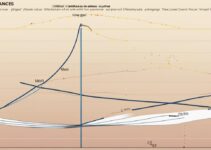I dedicate this article to those students taking advanced academic degrees where they eventually grapple with multiple regression analysis as a nifty tool in analyzing multiple variable relationships. Multiple Regression Analysis serves as a powerful statistical tool that lets us comprehend and interpret relationships between more than two variables.
This multifaceted landscape of regression analysis is well-utilized across a multitude of fields – from economics and business to health and social sciences. Understanding the basics, its assumptions, and their pertinence sets the stage for diving deep into the heart of this topic.
We then journey through the stages of conducting this analysis, interpreting its results, and handling potential problems. Ultimately, the illumination of its real-life applications wraps up our exploration with a comprehensive understanding of its practical relevance.
Table of Contents
The Basics of Multiple Regression Analysis
Multiple Regression Analysis Defined
Multiple regression analysis is a statistical technique used to predict the outcome of a dependent variable based on the value of two or more independent variables. It is an extension of simple linear regression analysis, which predicts the outcome of a dependent variable based on one independent variable.
For instance, multiple regression analysis can be used to predict a person’s weight based on their height and age. Notice that you have one independent (person’s weight) and two independent variables (height and age) in this example. A multiple regression model thus arises that can be used to predict a person’s weight based on their height and age.
I will expound on this concept in the next sections.
Components of Multiple Regression Analysis
The essential components of multiple regression analysis include the dependent variable, independent variables, and the regression coefficient. The dependent variable, also known as the response or outcome variable, is what we want to predict or explain. Independent variables, also referred to as predictor or explanatory variables, are the factors we believe have an effect on the dependent variable. The regression coefficient describes the size and direction of the relationship between the independent and dependent variables.
The dependent variable, also known as the response or outcome variable, is what we want to predict or explain. Independent variables, also referred to as predictor or explanatory variables, are the factors we believe have an effect on the dependent variable.
In multiple regression equations, you can also encounter the intercept and error term. The intercept is the value of the dependent variable when all independent variables are zero. The error term accounts for any variation in the dependent variable not explained by the independent variables.
Significance of Multiple Regression Analysis
Multiple regression analysis plays a vital role in various fields due to its predictive capabilities. In the field of economics, it can be used to understand how different factors like interest rates, inflation, and unemployment rates affect Gross Domestic Product or GDP. In business, it can help examine the impact of various factors on sales revenue like price, advertising expenditure, and the number of salespeople.
In the health sector, multiple regression can help identify key determinants of health outcomes like the impact of lifestyle factors and medical interventions on patient recovery rates. In social sciences, it might be used to predict outcomes based on demographic variables, attitudes, and behavior.
Procedure for Multiple Regression Analysis
The first step for a multiple regression analysis involves selecting and defining the dependent and independent variables based on the hypothesis or research question. The data for these variables is then collected and inputted into a statistical software program.
Once the variables are defined, a multiple regression model is developed, which predicts the value of the dependent variable based on the independent variables. The fit of the model is then tested using R-square value and F-statistic. R-square value tells the proportion of variance in the dependent variable which can be predicted from the independent variables. F-statistic is used to test if the model significantly predicts the dependent variable.
If the model fits the data well, predictor variables that significantly affect the dependent variable are identified using t-tests. If the model does not fit the data well or if assumptions of regression are violated, the model will need to be refined.
Assumptions of Multiple Regression Analysis
There are several assumptions that underpin multiple regression analysis. These assumptions include the linearity, independence, homoscedasticity, and normality of residuals.
Linearity assumes that the relationship between the dependent and independent variables is linear. Independence suggests that the residuals, the difference between the observed and predicted values of the dependent variable, are independent of each other. Homoscedasticity assumes that the variances along the line of best fit remain similar as you move along the line.
Finally, normality assumes that the residuals are normally distributed. Violations of these assumptions can lead to biases in your regression results and errors in your predictions. Therefore, it’s crucial to validate and, if necessary, adjust for violations of these assumptions as part of the multiple regression analysis.
Weaknesses of Predictive Potential of Multiple Regression Analysis
It’s vital to remember that while multiple regression analysis possesses a potent predictive potential, it falls short of confirming causal connections. This type of analysis is proficient in recognizing relationships among various variables, thereby aiding in forecasting future events. To illustrate, multiple regression may demonstrate a correlation between education level and income.
However, it can’t decisively establish that an increase in education leads to higher income. This level of causal confirmation would require an experimental research design.

Assumptions in Multiple Regression Analysis
The Role of Linearity in Multiple Regression Analysis
Linearity plays a pivotal role in multiple regression analysis, indicating that the correlation between independent and dependent variables can be effectively illustrated via a straight line. This doesn’t mean that the relationship will always precisely follow a linear path, but this linear representation acts as the most suitable approximation.
Various strategies, like scatter plots or residual plots, can be used to test the linearity assumption. If this assumption fails, it might lead to misleading interpretations of the regression coefficients, affect the accuracy in predicting the dependent variable, and cause other model analysis implications.
Independence
The independence assumption states that the residuals (the differences between the observed and predicted values of the dependent variable) are independent of each other. In simple terms, the value of the residual for one observation doesn’t depend on the value of the residual for any other observation.
Independence is critical to ensure the validity of the regression model. If the assumption is not met, it could lead to spurious or inflated relationships between the independent and dependent variables. Thus, the resulting multiple regression model becomes unreliable.
Homoscedasticity
Homoscedasticity refers to the assumption that the variance of the residuals is constant across all levels of the independent variables. This means that the spread of the residuals should be roughly the same for all predicted values of the dependent variable.
Testing for homoscedasticity can be done through visual inspections of residual plots or more formal tests like the Breusch-Pagan test. If this assumption is violated, it can lead to inefficient estimates of the coefficients and incorrect inferences.
Normality
The normality assumption in multiple regression analysis holds that the residuals of the model are normally distributed. This is important for the calculation of confidence intervals and hypothesis tests.
The validity of these statistical tools is largely based on the assumption of normality. If the assumption is violated, the precision of these statistical estimations may be compromised.
Checking the normality of residuals can be done visually using a histogram or a Q-Q plot, or by conducting statistical tests like the Shapiro-Wilk test.
Lack of Multicollinearity
Multicollinearity refers to a situation where two or more independent variables in a multiple regression model are highly correlated. The assumption here is that the independent variables should not be perfectly linearly related.
If this lack of multicollinearity assumption is violated, it won’t affect the prediction capability of the model. However, it makes it very hard to decipher how individual independent variables are related to the dependent variable. It can also make estimates of the coefficients unstable and difficult to interpret.
Summary
Understanding and maintaining the key assumptions of multiple regression analysis is crucial. It’s because any violations can lead to inaccurate conclusions about the interrelations among the variables.
Further, it may even put the reliability of the overall model predictions and conclusions at risk. Therefore, one of the essential tasks for an analyst employing multiple regression analysis is to ensure these assumptions are assessed and appropriately addressed.

8 Steps in Conducting Multiple Regression Analysis
1. Initiating the Process
Beginning with the multiple regression analysis process involves defining the research problem in a clear and concise manner. This encompasses identifying the dependent or target variables – these are what you are trying to predict or comprehend.
Simultaneously, it’s also important to identify the independent variables, which are believed to influence the dependent variables. Crucially, these variables should be quantifiable or expressible in numerical terms.
2. Developing a Model
Next, you will develop a model based on the problem defined in the previous step. The model is essentially a mathematical equation that describes the relationship between the dependent and independent variables.
This equation involves coefficients which are the constants that multiply with the independent variables to estimate the dependent variable.
3. Formulating the Hypotheses
The next step is to formulate the null and alternative hypotheses. The null hypothesis would be a statement suggesting there is no relationship between the dependent and independent variables, while the alternative hypothesis asserts that there is a relationship.
4. Collecting the Data
Data collection is a crucial step in regression analysis. Depending on the nature of your research, data can be collected through various ways such as surveys, experiments, observations, or secondary data sources like census data or other databases.
5. Analyzing the Data
The next step is to perform a multiple regression analysis using statistical software. The software takes the collected data and applies it to your model, analyzing how the independent variables relate to the dependent variable. The software will produce an output, outlining the impact of each independent variable on the dependent variable.
6. Testing the Hypotheses
The resulting output from the analysis will be used to test the hypotheses formulated earlier. If the p-value (a value representing the probability that the null hypothesis is true) is less than or equal to the significance level (often 0.05), the null hypothesis is rejected in favor of the alternative. This would support the assertion that there is a relationship between the dependent and independent variables.
7. Interpreting the Results
Finally, the results from the test are then interpreted. The coefficient values derived from the model will give an estimate of the impact of each independent variable on the dependent variable. The significance level and confidence intervals of the estimates can provide further insight on the reliability of these estimates.
Lastly, the R square value, which indicates the proportion of the variance in the dependent variable that is predictable from the independent variables, gives a measure of how well the model fits the data.
8. Iterative Process of Model Refinement
When a chosen model fails to accurately fit the data, it necessitates the repetition of the analysis process. This can involve refinements such as integrating interaction terms, adding additional variables, excluding variables that are inconsequential, or evolving the established variables.
Subsequently, the improved model must be reassessed, calling for a reanalysis of the data and thus commencing a new cycle of regression analysis.
It’s crucial to highlight that this is an iterative process, potentially requiring several cycles before arriving at a model that satisfactorily mirrors the phenomenon under examination. The groundwork for success rests upon prudent preparation, precise definition of variables, meticulous data collection and insightful analysis.

Interpretation and Use of the Multiple Regression Equation
Deciphering Multiple Regression Analysis
Multiple regression analysis is a sophisticated statistical method employed to predict the value of a particular variable, drawing upon the influence of two or more independent variables. As an extension of simple linear regression, it assumes a linear interconnection between the dependent and independent variables and brings multiple predictors into play.
Interpreting Coefficients in Multiple Regression Analysis
In multiple regression analysis, coefficients represent the relationship between the independent variable and the dependent variable. Each coefficient shows the change in the dependent variable for each one-unit change in the respective independent variable while keeping all other predictors constant.
For example, if a coefficient is positive, an increase in the independent variable will result in an increase in the dependent variable, assuming all other variables remain constant. Conversely, a negative coefficient suggests that an increase in the independent variable will decrease the dependent variable.
P-Values in Multiple Regression Analysis
P-values in multiple regression analysis are used to ascertain the significance of the relationship between the independent variables and the dependent variable. The null hypothesis in multiple regression assumes no relationship between the dependent and independent variables.
When the p-value is less than a pre-specified significance level, often 0.05, it suggests that there is a statistically significant relationship between the independent variable and the dependent variable. A smaller p-value means stronger evidence in favor of an association.
R-Squared in Multiple Regression Analysis
R-squared, also known as the coefficient of determination, is a statistical measure that depicts how well the regression predictions approximate the real data points. An R-squared of 100% indicates that all variations in the dependent variable can be completely explained by the independent variables.
However, an R-squared of 0% indicates that the independent variables explain none of the variability of the response data around its mean. It’s often expressed as a percentage and gives a sense of the “fit” of the model.
Practical Uses of Multiple Regression Analysis
Multiple regression analysis is widely used across different fields and sectors for varied purposes. In business, it could be used to forecast sales based on different influencing factors like population size, income level, and competitors’ prices. In healthcare, it can help figure out the factors that influence the progression of diseases or determine the impact of various treatment interventions on patients’ health outcomes. In social sciences, it can be used to identify the factors contributing to social phenomena or trends.
Multiple regression analysis can yield invaluable insights by revealing associations between variables. However, it is crucial to remember that it does not establish causality, demonstrating merely an association, not a cause-effect relationship.
It heavily relies on the selection of suitable independent variables and the making of correct assumptions concerning their relationship with the dependent variable. Misinterpretations and errors can easily crop up if these factors are not appropriately considered.

Potential Problems and Solutions in Multiple Regression Analysis
The Issue of Multicollinearity
An often-encountered problem in multiple regression analysis is multicollinearity, which arises when the independent variables in a regression model are closely correlated with each other. This strong correlation can undermine the examination’s statistical power, potentially yielding incorrect results. It can cause researchers to mistakenly overlook the importance of some variables while overestimating others.
One common method to identify multicollinearity is using the Variance Inflation Factor (VIF). If an independent variable has a high VIF value, this is indicative of high multicollinearity.
Solutions to Multicollinearity
There are several ways to address multicollinearity. One way is to drop one of the correlated variables from the analysis. Alternatively, a researcher could consolidate highly correlated variables into a single factor.
Using a data pre-processing technique, like Principal Component Analysis (PCA), can also help, as it transforms the correlated variables into a set of uncorrelated ones.
The Problem of Autocorrelation
Autocorrelation, also a common problem in multiple regression analysis, occurs when the residuals are not independent of each other. This means error terms are correlated. Autocorrelation can lead to misleading statistical results, such as increased Type I errors or decreased statistical power.
To detect autocorrelation, one can use the Durbin-Watson test. The Durbin-Watson statistic ranges from 0 to 4, with a value around 2 suggesting no autocorrelation.
Solutions to Autocorrelation
To combat autocorrelation, a researcher might use a time-series model, such as Autoregressive Integrated Moving Average (ARIMA) models or autoregressive models. Another method is to apply transformations to the data. Detrending the data, differencing the data, or using a lag can suppress autocorrelation.
The Problem of Heteroscedasticity
Heteroscedasticity is another possible problem in multiple regression analysis. It occurs when the variance of the errors or residuals from the model is not constant across all levels of the independent variables. This violates the assumption of homoscedasticity in regression analysis and can lead to incorrect standard errors and thus erroneous statistical inferences.
The Breusch-Pagan test or White test is often used to detect heteroscedasticity. If heteroscedasticity is present, the p-value will be less than the significance level (0.05).
Solutions to Heteroscedasticity
When facing heteroscedasticity, one might apply data transformations, such as logarithms or square roots, to stabilize the variance across the levels of independent variables. Another practice is to use robust standard errors, which correct statistical inferences for heteroscedasticity.
Alternatively, using a heteroscedasticity-consistent covariance matrix estimator (HCCME) can yield valid standard errors and statistical inferences, even when heteroscedasticity is present.
Understanding and resolving common issues in data analysis is pivotal for researchers. By doing so, they can carry out a more sophisticated and precise multiple regression analysis, notably beneficial in fields like healthcare and more.

Real-life Scenario of Multiple Regression Analysis
The Role of Multiple Regression Analysis in Healthcare
In the healthcare sector, multiple regression analysis proves to be a powerful tool used to predict particular outcomes based on multiple independent variables.
Consider the task of predicting the probable risk of developing diseases; doctors might look at factors such as age, weight, gender, predisposed genetics, and lifestyle. By using this analysis, they can design patient-specific treatment plans, optimizing the quality of healthcare provided.
Furthermore, public health officials utilize multiple regression analysis to evaluate the effectiveness of interventions and policies at a broad population level.
Regression Analysis in Marketing
In the field of marketing, businesses leverage multiple regression analysis to evaluate the success of their advertising efforts. They consider variables such as the type of media, frequency of the ad, time of airing, and potential audience to estimate the impact on their sales. This expertise equips businesses to make strategic decisions on where, when, and how often to advertise for optimal return on investment.
Financial Forecasting and Multiple Regression Analysis
In finance, professionals use multiple regression analysis to predict financial trends and future values of companies. By considering factors such as market trends, interest rates, inflation, and economic indicators, analysts can forecast the future stock price of a corporation, guide investment decisions, and develop business strategies.
Real Estate and Multiple Regression Analysis
Real estate professionals often employ multiple regression analysis to evaluate property values. Certain factors like location, size of the property, age, proximity to amenities, and quality of local schools significantly affect the property prices. By analyzing these multiple variables, realtors can estimate the accurate value of a property and guide clients in making informed purchasing decisions.
Production Optimization and Multiple Regression Analysis
In manufacturing and production sectors, multiple regression analysis is frequently used to optimize production processes. Factors such as temperature, pressure, speed, and raw material could affect the quality and quantity of production. By analyzing these factors, managers can adjust the variables to ensure optimal production, minimize waste, and maximize efficiency.
Sports Performance Analysis with Multiple Regression
Sports scientists and coaches utilize multiple regression analysis to optimize athletes’ performance. By considering multiple variables such as training intensity, nutrition, sleep patterns, and mental health, they can predict an athlete’s performance and devise personalized training plans.
The widespread use of multiple regression analysis across various sectors underscores its importance in aiding decision-making processes. From healthcare and marketing to real estate and sports, this statistical tool is instrumental in analyzing complex situations with numerous independent variables. It allows experts to make accurate predictions and informed decisions, thus enhancing the efficiency of their respective fields.

Key Takeaways
Through the intricate realm of Multiple Regression Analysis, we observe the dynamics of multivariate relationships and their profound impacts on decision making and predictions. Identifying the pitfalls and troubleshooting them, further enhance our competence in employing this statistical tool effectively.
Rich insights drawn from real-life scenarios underline the fact that this tool’s utility reaches far beyond academia, influencing diverse sectors. As we continue to iterate on and refine our understanding of Multiple Regression Analysis, we stand to unlock even more profound actionable insights and correlations, thus enriching both discourse and analysis in multivariate studies.



